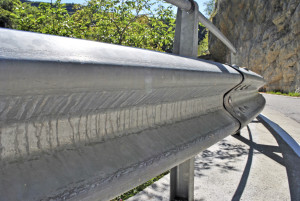The investigation of an accident in Texas led to a whistleblower lawsuit alleging that a design change increased the risk of injury or death in accidents involving the Trinity ET-Plus guardrail. According to the lawsuit, Trinity made the changes to the rail head of the guardrail in 2005 but neglected to inform the Federal Highway Administration (FHA) of the change before the agency purchased the product for use throughout the country.
Trinity Makes Design Changes to the ET-Plus

According to the Trinity whistleblower lawsuit, the original design of the ET-Plus guardrail consisted of a five-inch-long metal component that was reduced to four inches in 2005. The guardrail is intended to absorb the shock of an impact and fold like an accordion, but the reduction in size allegedly increased the likelihood that the rail head would jam and function like a bayonet instead of a cushion for the vehicle. Internal documents from the company suggest that Trinity reduced the size of the metal piece on the ends of the guardrails to save $50,000 a year.
ET-Plus Guardrail Reported to Increase Risk of Injury or Death
In an effort to compare the previous ET-Plus model with the redesigned product, as well as other guardrail models in use across the country, The Safety Institute studied car crash data from 2005 to 2014 in Ohio and Missouri. While there was no significant evidence to report in terms of the three non-Trinity guardrails, researchers found that the ET-Plus was 2.86 times more likely to cause a fatality than the previous model. Additionally, the ET-Plus was found to be 1.36 times more likely to cause passenger or driver injury.
As a result of the study as well as the increasing reports of injury and deaths allegedly caused by the guardrail, 39 states, including Colorado, have banned the ET-Plus from roadways. According to a 7NEWS news report out of Denver, the Colorado Department of Transportation (CDOT) said on October 23, 2014 that it will put a moratorium on purchasing and installing the ET-Plus. While a CDOT spokeswoman said that it will continue to use the guardrails, it will reevaluate the situation after the Federal Highway Administration finishes safety testing.
A CDOT representative stated that as of November 2014, the guardrails have been involved in any injuries or deaths in Colorado. However, according to an article in The New York Times, at least 14 car crashes involving five deaths and numerous injuries in the U.S. have involved the ET-Plus System.
$175 Million Verdict Against Trinity
Following the trial of the whistleblower lawsuit, a jury returned a verdict of $175 million against Trinity. Jurors found that Trinity had defrauding the government by failing to inform the FHA of the design changes to the ET-Plus. The lawsuit, alleged that Trinity’s negligence placed motorists at an increased risk of death or severe injury. While the initial verdict was for $175 million, the amount could be tripled under the federal False Claims Act.
People injured in an accident involving the ET-Plus guardrail may be eligible to file their own Colorado Trinity guardrail lawsuit. A Colorado personal injury attorney can recreate the scene of the accident, interview physicians and witnesses, and arrange for medical experts to testify on your behalf to help increase your chance of a desirable outcome.
Injured by a Trinity Guardrail? Call Attorney Group for Colorado
If you were injured in a car accident and you believe that a Trinity ET-Plus guardrail caused or worsened your injuries, contact Attorney Group for Colorado for a free consultation with no out-of-pocket cost to you. We can help answer your questions and connect you with an affiliated attorney who can file a Colorado Trinity guardrail lawsuit on your behalf. You may be entitled to seek compensation for lost wages, pain and suffering, and medical expenses.





